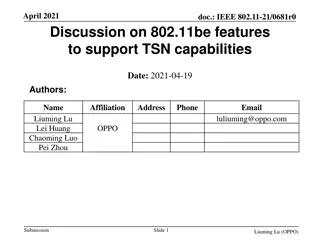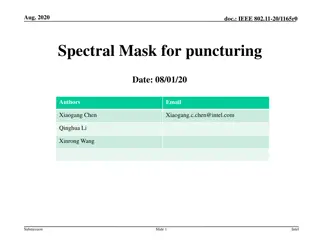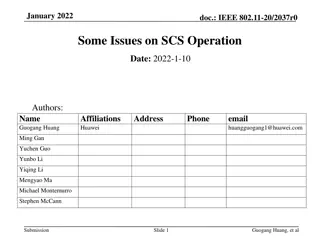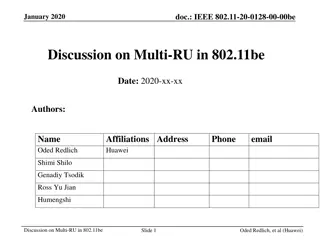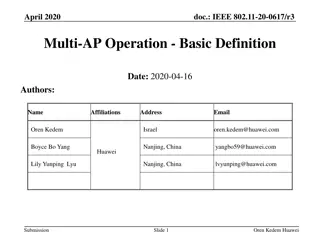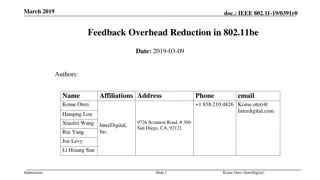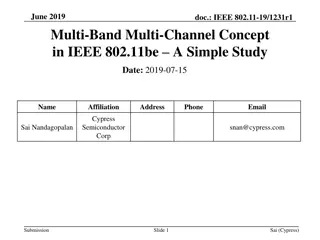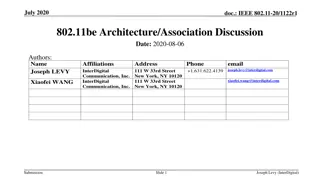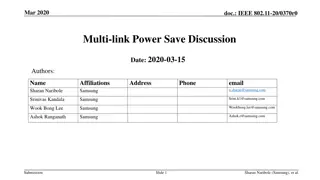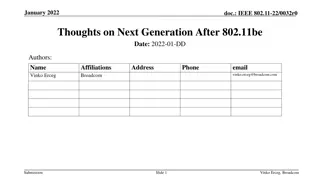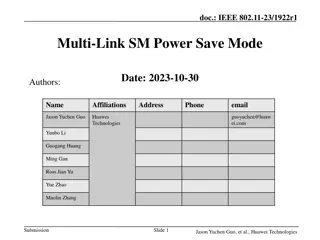Overview of Multi-AP Operation in IEEE 802.11be
The document discusses the unique feature of multi-AP operation in IEEE 802.11be, emphasizing the performance benefits in various deployments. It addresses the need for AP-to-AP communication, the concept of anchor APs, interfaces for inter-AP communication, and backhaul options. The importance of forming multi-AP operation sets with or without anchors is outlined, along with the role and requirements of anchor APs in coordinating and managing AP groups. Considerations for logical data and control channels, group forming, sharing context, resource scheduling, and synchronization among APs are also explored.
Download Presentation

Please find below an Image/Link to download the presentation.
The content on the website is provided AS IS for your information and personal use only. It may not be sold, licensed, or shared on other websites without obtaining consent from the author.If you encounter any issues during the download, it is possible that the publisher has removed the file from their server.
You are allowed to download the files provided on this website for personal or commercial use, subject to the condition that they are used lawfully. All files are the property of their respective owners.
The content on the website is provided AS IS for your information and personal use only. It may not be sold, licensed, or shared on other websites without obtaining consent from the author.
E N D
Presentation Transcript
Jan 2020 doc.: IEEE 802.11-20/0064r1 Overview of Multi-AP Operation in 11be Authors: Name Affiliations Address Email Boyce Bo Yang Nanjing, China yangbo59@huawei.com Lily Yunping Lyu Nanjing, China lvyunping@huawei.com Huawei Chenhe Ji Nanjing, China jichenhe@huawei.com Submission Slide 1 Boyce Bo Yang(Huawei), et al.
Jan 2020 doc.: IEEE 802.11-20/0064r1 Introduction Multi-AP operation is a significantly different feature for 802.11be comparing to previous standard versions, benefiting performance in typical deployments. Many candidate technologies have been proposed, like: Joint Transmission[1][2], Coordinated Beamforming (uplink and downlink)[3][4], Coordinated OFDMA[5][6][7], Coordinated Spatial Reuse[8], etcetera, all necessitating AP-to-AP communication. The unified architecture has not been fully discussed. Whether an anchor is needed for multi-AP operation, roaming anchor, scheduling anchor, managing anchor. Whether interfaces should be defined for inter-AP communication. Whether a backhaul is existed for inter-ap operation, wired or wireless. The scope of 802.11be has not been defined for multi-AP operation. Submission Slide 2 Boyce Bo Yang(Huawei), et al.
Jan 2020 doc.: IEEE 802.11-20/0064r1 Anchor of a Multi-AP operation set Multi-AP operation set A Multi-AP operation set is a set of APs involving in multi-AP operation. A reliable link should exist within the Multi-AP operation set, wired or wireless. The requirement to form a Multi-AP operation set should be defined. Multi-AP operation set with anchor An anchor of an Multi-AP operation set is a logic coordinator \ scheduler \ distributor \ context manager, residing in one of the APs or an independent device. The Multi-AP operation set is a close coupled group of APs, with explicit hierarchical structure, dedicated wired or wireless backhaul, and intra-set interfaces. In the case of mesh APs, a fixed AP portal acts as the data distributor. In the case of enterprise APs, an AP is chosen semi-statically acting as the coordinator. Multi-AP operation set without anchor The Multi-AP operation set is a loosely coupled group of APs, which may be formed dynamically. Same wireless link is used to transmit inter-AP information and AP-to-STA information. Anchor AP AP AP AP AP AP Submission Slide 3 Boyce Bo Yang(Huawei), et al.
Jan 2020 doc.: IEEE 802.11-20/0064r1 Interfaces for inter-AP communication Logical data channel for joint transmission and reception. Data distribution is needed for joint transmission and reception The amount of data is comparable to fronthaul, and the effective rate is[9] 1 1 +?? ?? min ?? ,?? , Logical control channel for all kinds of Multi-AP operation Control information is more sensitive to packet loss and delay. Multi-AP operation Group forming Associated STA context sharing Radio resource schedule results Channel state information sharing Synchronization between APs Control channel should have higher priority. , ??? ???????? ???? ??? ????= ??? ????? ???? ??? Submission Slide 4 Boyce Bo Yang(Huawei), et al.
Jan 2020 doc.: IEEE 802.11-20/0064r1 Backhaul for inter-AP communications (1) Dedicated Backhaul (Wired/Wireless) In enterprise and some residential scenarios, wired backhaul is part of the infrastructure. In home scenarios, wireless backhaul is a typical mesh deployment. Logical data channel and logical control channel between APs are mapped to wired/wireless physical backhaul. Coordinated Scheduling CSI Sharing STA context sharing Group forming Data & clock Distributing STA Transmission and acknowledgement association AP 1 AP 2 AP 3 STA 11 STA 21 STA 31 Backhaul Fronthaul Notes: 1. 2. We do not mean to show any technical opinion in the detailed procedure of the slash boxes Fronthual is the link that can be heard by non-AP STAs. Submission Slide 5 Boyce Bo Yang(Huawei), et al.
Jan 2020 doc.: IEEE 802.11-20/0064r1 Backhaul for inter-AP communications (2) No Dedicated Backhaul In scenarios where very limited information exchange is needed, coordinated information is transmitted at the fronthaul in a TDM manner. No data sharing needed for loose coupled group. Control information is exchanged before multi-AP data transmission/reception and acknowledgement. Scheduling for STAs Scheduling for STAs individually Dynamic Group forming and scheduling for APs Multi-AP transmission and acknowledgement M AP 1 AP 2 AP 3 STA 11 STA 21 STA 31 Submission Slide 6 Boyce Bo Yang(Huawei), et al.
Jan 2020 doc.: IEEE 802.11-20/0064r1 Observations Detailed procedures may vary for different presumptions and multi-AP operations (JT, C- OFDMA, C-BF, C-SR, etcetera). A lot of work need to be done if we go through every potential multi-AP operations. However, it would be much easier to move the first step forward if we just focus on MultiAP-to- STA operations, enabling multi-AP operations in 802.11be with necessary interactions only. Submission Slide 7 Boyce Bo Yang(Huawei), et al.
Jan 2020 doc.: IEEE 802.11-20/0064r1 Priority of multi-AP operation in 802.11be development(1) AP-AP communication is not mandatory in 802.11be. Multi-AP operation could also be accomplished if inter-AP communication was left to implementations. AP-STA communication is mandatory in 802.11be. For non-AP STA operations, we shoud do it with minimal changes. The reception of Coordinated OFDMA PPDU should be operated like single-AP OFDMA. The reception of Coordinated Beamforming PPDU should be operated like single AP SU/MU MIMO. The reception of Joint transmission PPDU should be operated like single-AP MU-MIMO. Submission Slide 8 Boyce Bo Yang(Huawei), et al.
Jan 2020 doc.: IEEE 802.11-20/0064r1 Priority of multi-AP operation in 802.11be development(2) First Priority - minimum requirement to achieve AP coordination New definitions and general mechanism New definitions introduced by multi AP, such as multi-AP operation group General mechanism of AP-AP communications over fronthaul, like, a vendor-specific inter-AP communication frame ( which may act as SyncTrigger in JT, COA in COFDMA, C_Request /C_response in C-BF, ) Non-AP STA related procedures Multi-AP Sounding STA to Multi-AP association Multi-AP acknowledgement and other immediate feedbacks Other necessary procedures to enable Multi-AP operation Submission Slide 9 Boyce Bo Yang(Huawei), et al.
Jan 2020 doc.: IEEE 802.11-20/0064r1 Priority of multi-AP operation in 802.11be development(3) Second Priority could be left to later stage or left to implementation Detailed procedure of Data distribution Detailed procedure of multi-AP operation group forming Detailed procedure of associated STA context sharing Detailed procedure of radio resource scheduling Detailed procedure of channel state information sharing Detailed procedure of synchronization between APs Other procedures to optimize Multi-AP operation Submission Slide 10 Boyce Bo Yang(Huawei), et al.
Jan 2020 doc.: IEEE 802.11-20/0064r1 Summary We discussed architecture of Multi-AP operations with different presumptions for different scenarios. Based on the wide variety of Multi-AP operation modes, we suggest 802.11be focus on necessary procedures involving non-AP STAs as the first priority. Multi-AP operation could also be accomplished in practice if AP-to-AP communication was left to implementation. Meanwhile the standard work would be very simple. Submission Slide 11 Boyce Bo Yang(Huawei), et al.
Jan 2020 doc.: IEEE 802.11-20/0064r1 References [1] 11-19-1597-00-00be-jt-performance-with-multiple-impairments [2] 11-19-1092-01-00be-evaluation-of-joint-transmission [3] 11-19-1779-03-00be-downlink-spatial-reuse-parameter-framework-with-coordinated- beamforming-null-steering-for-802-11be [4] 11-19-1903-00-00be-uplink-coordinated-multi-ap [5] 11-19-1788-00-00be-coordinated-ofdma-operation [6] 11-19-1879-00-00be-coordinated-ap-time-and-frequency-sharing-gain-analysis [7] 11-19-1592-00-00be-simulation-results-for-coordinated-ofdma-in-multi-ap-operation [8] 11-19-1534-00-00be-coordinated-spatial-reuse-performance-analysis [9] 11-19-1588-00-00be-multi-ap-backhaul-analysis Submission Slide 12 Boyce Bo Yang(Huawei), et al.
Jan 2020 doc.: IEEE 802.11-20/0064r1 Straw Poll Do you agree that 802.11be should focus on developing new definitions, general mechanism and non-AP STA related procedures to enable multi- AP operation? Other operations which do not involve non-AP STA could be discussed in 802.11be or left to implementation. Yes No Abstain Submission Slide 13 Boyce Bo Yang(Huawei), et al.



